RS Aggarwal Solutions Class 10 Chapter 16 Co-ordinate Geometry
These Solutions are part of RS Aggarwal Solutions Class 10. Here we have given RS Aggarwal Solutions Class 10 Chapter 16 Co-ordinate Geometry
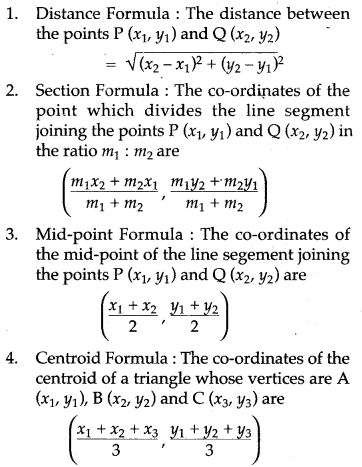
Exercise 16A

Question 1:
(i) The given points are A(9,3) and B(15,11).
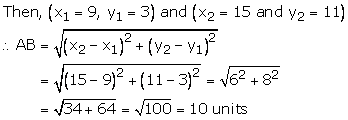
(ii) The given points are A(7,4) and B(-5,1).
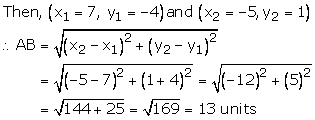
(iii) The given points are A(-6, -4) and B(9,-12).

(iv) The given points are A(1, -3) and B(4, -6).

(v) The given points are P(a + b, a – b) and Q(a – b, a + b).
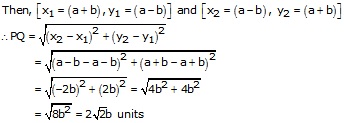
(vi) The given points are P(a sin a, a cos a) and Q(a cos a, – a sina).
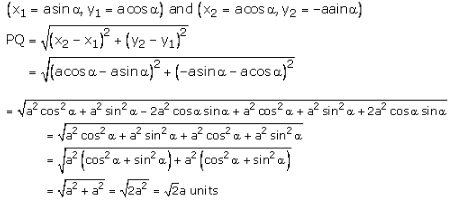
Question 2:
(i) The given point is A(5, -12) and let O(0,0) be the origin.

(ii) The given point is B(-5, 5) and let O(0,0) be the origin.

(iii) The given point is C(-4, -6) and let O(0,0) be the origin.

More Resources
Question 3:
The given points are A(a, -1) and B(5,3).

Question 4:
Let R(10,y) be the point at a distance of 10 units from P(2, -3).

Question 5:
Let A(6, -1), B(1,3) and C(k,8) are the given points.

Question 6:
Let A(a, 2), B(8, -2) and C(2,-2) be the given points. Then first we find:

Therefore, a = 5
Question 7:
Let any point P on x – axis is (x,0) which is equidistant from A(-2, 5) and B(-2, 9).

This is not admissible.
Hence, there is no point on x – axis which is equidistant from A(-2, 5) and B(-2, 9).
Question 8:
Let any point P on x – axis is (0,y) which is equidistant from A(5, -2) and B(-3, 2)
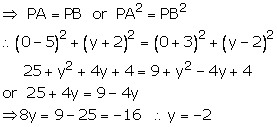
Thus, the point on y – axis is (0, -2).
Question 9:
he point A(4,3) and B(x,5) lie on a circle. Its centre is O(2,3)

Question 10:
Let A(6, -1) and B(2,3) be the given point and P(x,y) be the required point, we get

Question 11:
Let A(11, -8) be the given point and let P(x,0) be the required point on x – axis
Then,
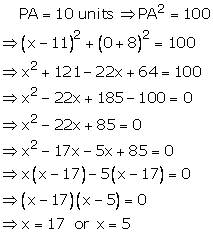
Hence, the required points are (17,0) and (5,0).
Question 12:
Let the required points be P(x,y), then
PA = PB = PC. The points A, B, C are (5,3), (5, -5) and (1, -5) respectively.
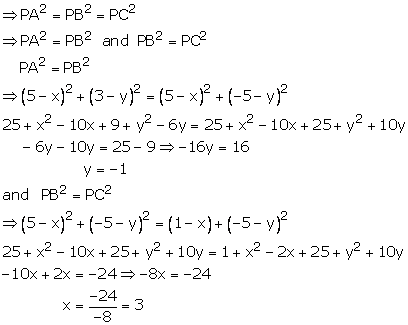
Hence, the point P is (3, -1).
Question 13:
Let A(1, -1), B(5, 2) and C(9, 5) are the given points. Then

Hence the given points A, B, C are collinear.
Question 14:
(i) Let A (6,9), B(0,1) and C(-6, -7) be the given points. Then
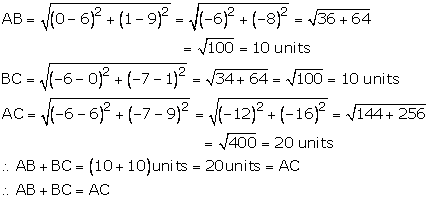
Hence the given A, B, C are collinear.
(ii) Let A(-1, -1), B(2,3) and C(8,11) be the given points. Then
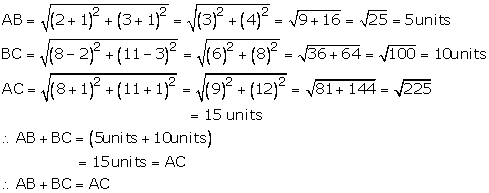
Hence the given A, B, C are collinear.
(iii) Let P(1,1), Q(-2,7) and R(3, -3) be the given points, then

(iv) Let P(2,0), Q(11,6) and R(-4,-4) be the given points
Then,
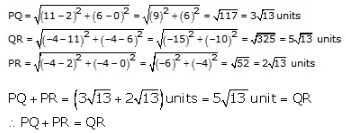
Hence the given P, Q, R are collinear.
Question 15:
Let A(3,0), B(6,4) and C(-1,3) are the given points. Then
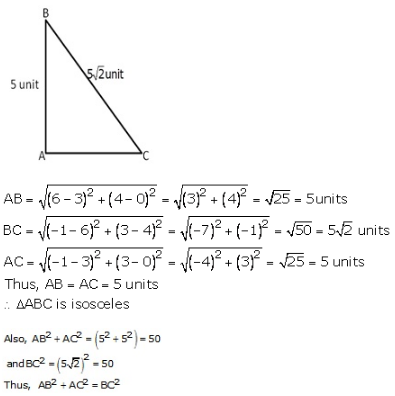
∴ ∆ ABC is an isosceles right – angled triangle.
This shows that ∆ ABC is right angled at A.
Question 16:
Vertices of triangle ABC are A(7, 10), B(-2, 5) and C(3, -4)

∴ ∆ ABC is a right angled triangle.
Hence ∆ ABC is an isosceles right triangle.
Question 17:
Let A(-5,6), B(3,0) and C(9,8) be the given points. Then

Question 18:
Let O(0,0), A(3,√3) and B(3,-√3) are the given points.
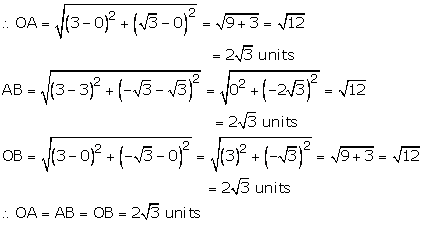
Hence, DABC is equilateral and each of its sides being 2√3 units.

Question 19:
Let A(2,1), B(5,2), C(6,4) and D(3,3) are the angular points of a parallelogram ABCD. Then
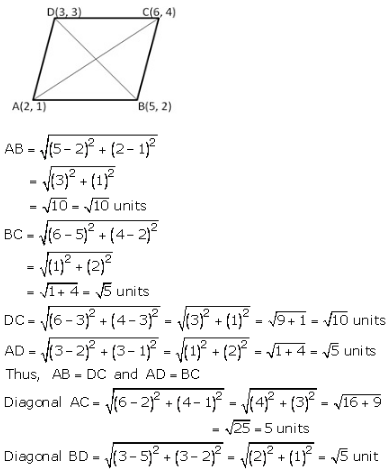
Diagonal AC ≠ Diagonal BD.
Thus ABCD is not a rectangle but it is a parallelogram because its opposite sides are equal and diagonals are not equal.
Question 20:
(i) Let A(0, -4), B(6,2), C(3,5) and D(-3,-1) are the vertices of quad. ABCD. Then

Thus, ABCD is a quadrilateral whose opposite sides are equal and the diagonals are equal.
Hence, quad. ABCD is a rectangle.
(ii) Let A(2, -2), B(14, 10), C(11, 13) and D(-1, 1) be the angular points of quad. ABCD, then
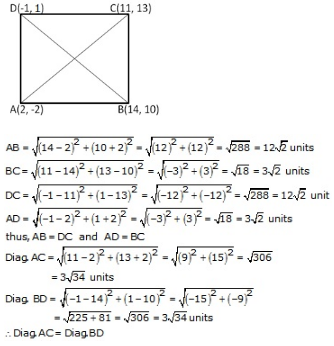
Thus, ABCD is a quadrilateral whose opposite sides are equal and diagonals are equal.
Hence, quad. ABCD is rectangle.
(iii) Let A(-4, -1), B(-2, -4), C(4, 0) and D(2, 3) are the vertices of quad. ABCD. Then

Thus, ABCD is a quadrilateral whose opposite sides are equal and the diagonals are equal
Hence, quad. ABCD is a rectangle.
Question 21:
(i) Let A(6,2), B(2,1), C(1,5) and D(5,6) be the angular points of quad. ABCD. Join AC and BD
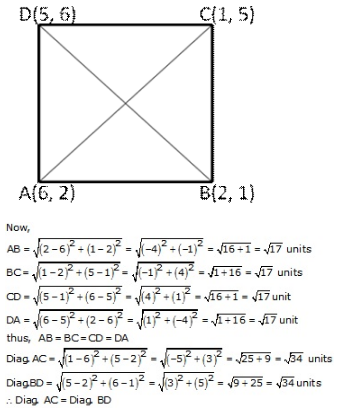
Thus, ABCD is a quadrilateral in which all sides are equal and the diagonals are equal.
Hence, quad ABCD is a square.
(ii) Let P(0, -2), Q(3,1), R(0,4) and S(-3,1) be the angular points of quad. ABCD
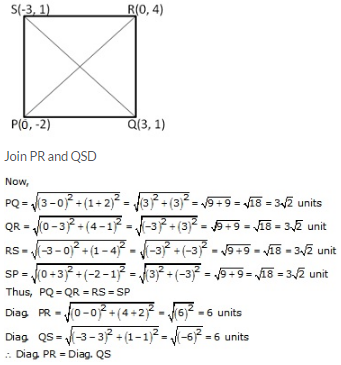
Thus, PQRS is a quadrilateral in which all sides are equal and the diagonals are equal.
Hence, quad. PQRS is a square.
(iii) The angular points of quadrilateral ABCD are A(3,2), B(0,5), C(-3,2) and D(0,-1)

Thus, all sides of quad. ABCD are equal and diagonals are also equal.
Quad. ABCD is a square.
Question 22:
Let A(-3,2), B(-5, -5), C(2, -3) and D(4,4) be the angular point of quad ABCD. Join AC and BD.
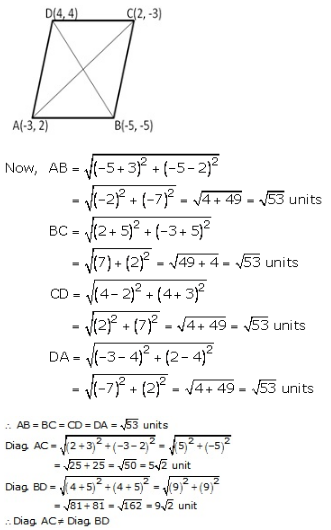
Thus, ABCD is a quadrilateral having all sides equal but diagonals are unequal.
Hence, ABCD is a rhombus.

Exercise 16B
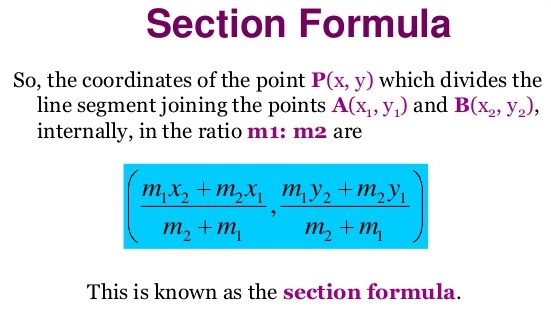
Question 1:
The end points of AB are A(-1,7) and B(4, -3).
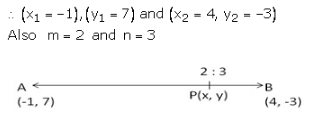
Let the required point be P(x, y)
By section formula, we have
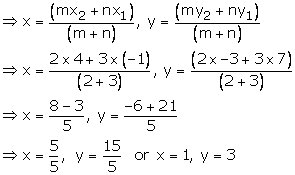
Hence the required point is P(1, 3).
Question 2:
The end points of PQ are P(-5, 11) and Q(4, -7).
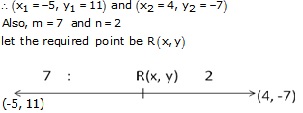
By section formula, we have

Hence the required point is (2, -3).
Question 3:
Let P(x, y) and Q(p,q) be the points of trisection of the line segment. Joining A(2,1) and B(5, -8)
The, P(x, y) divide AB in the ratio 1 : 2.

By section formula, we have
![]()
Here m = 1 and n = 2

P(3, -2) is the 1st point of trisection of AB
Also Q(p, q) divides AB in the ratio 2 : 1
Here m = 2 and n = 1
(x1=2, y1=1) and (x2=5, y2=-8)

Q(4, -5) is the 2nd point of trisection of AB
Hence P(3, -2) and Q(4, -5) are the required point.
Question 4:
Let P(x, y) and Q(p, q) be the point of trisection of line segment A(-4, 0) and B(0, 6)
Then P(x, y) divides AB in the ratio 1 : 2

Here m = 1 and n = 2
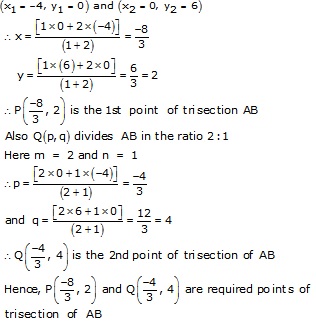
Question 5:
Point P divides the join of A(3, -4) and B(1,2) in the ratio 1 : 2.
Coordinates of P are:
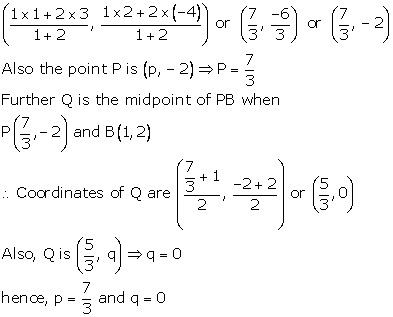
Question 6:
Let (x, y) be the coordinates of a point P which divides the line joining A(4, -5) and B(4, 5) such that AP : AB = 2 : 5
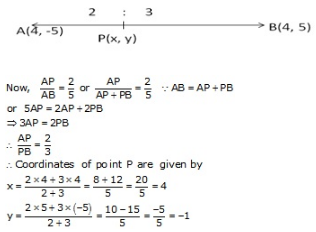
Coordinates of P are (4, -1)
Question 7:
(i) The coordinates of mid – points of the line segment joining A(3, 0) and B(-5, 4) are ![]()
(ii) Let M(x, y) be the mid – point of AB, where A is (-11, -8) and B is (8, -2). Then,

Question 8:
The midpoint of line segment joining the points A(6, -5) and B(-2, 11) is
![]()
Also, given the midpoint of AB is (2, p)
⇒ p = 3
Question 9:
C(1, 2a + 1) is the midpoint of A(2a, 4) and B(-2, 3b)

Question 10:
Points P, Q, R divide the line segment joining the points A(1,6) and B(5, -2) into four equal parts
Point P divide AB in the ratio 1 : 3 where A(1, 6), B(5, -2)
![]()
Therefore, the point P is

Also, R is the midpoint of the line segment joining Q(3, 2) and B(5, -2)
![]()
Question 11:
Let A(-2, 9) and B(6, 3) be the two points of the given diameter AB and let C(a, b) be the center of the circle.
Then, clearly C is the midpoint of AB
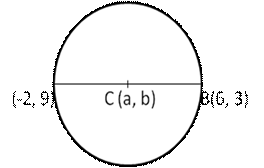
By the midpoint formula of the co-ordinates,

Hence, the required point C(2, 6).
Question 12:
A, B are the end points of a diameter. Let the coordinates of A be (x, y).
The point B is (1, 4)
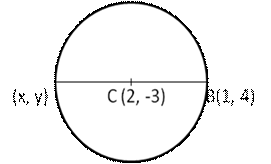
The center C(2, -3) is the midpoint of AB.

The point A is (3, -10).
Question 13:
Let P divided the join of A(8, 2), B(-6, 9) in the ratio k : 1
By section formula, the coordinates of p are
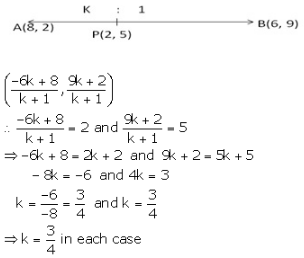
Hence, the required ratio of (\(\frac { 3 }{ 4 } \) : 1) which is (3 : 4)
Question 14:
Let P(-6, a) divides the join of A(-3, -1) and B(-8, 9) in the ratio k : 1
Then the coordinates of P are given by
![]()
But, we are given P is (-6, a)

Hence, required ratio is 3 : 2 and a = 5
Question 15:
Let P divided the join of line segment A(-4, 3) and B(2, 8) in the ratio k : 1
∴ the point P is
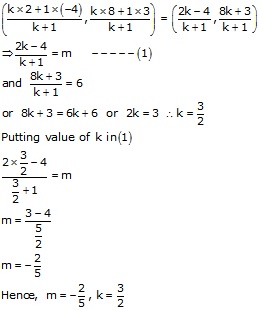
Question 16:
Let P is dividing the given segment joining A(-5, -4) and B(-2, 3) in the ratio r : 1

Coordinates of point P

Question 17:
Let the x- axis cut the join of A(2, -3) and B(5, 6) in the ratio k : 1 at the point P
Then, by the section formula, the coordinates of P are ![]()
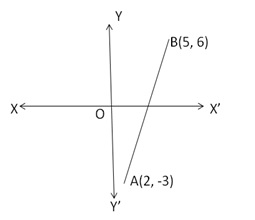
But P lies on the x axis so, its ordinate must be 0

So the required ratio is 1 : 2
Thus the x – axis divides AB in the ratio 1 : 2
Putting ![]() we get the point P as
we get the point P as

Thus, P is (3, 0) and k = 1 : 2
Question 18:
Let the y – axis cut the join A(-2, -3) and B(3, 7) at the point P in the ratio k : 1
Then, by section formula, the co-ordinates of P are
![]()
But P lies on the y-axis so, its abscissa is 0
![]()
So the required ratio is \(\frac { 2 }{ 3 } \) : 1 which is 2 : 3
Putting ![]() we get the point P as
we get the point P as

i.e., P(0, 1)
Hence the point of intersection of AB and the y – axis is P(0, 1) and P divides AB in the ratio 2 : 3
Question 19:
Let the line segment joining A(3, -1) and B(8, 9) is divided by x – y – 2 = 0 in ratio k : 1 at p.
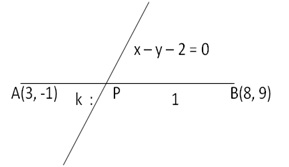
Coordinates of P are

Thus the line x – y – 2 = 0 divides AB in the ratio 2 : 3
Question 20:
Let D, E, F be the midpoint of the side BC, CA and AB respectively in ∆ABC.
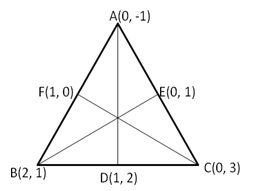
Then, by the midpoint formula, we have

Hence the lengths of medians AD, BE and CF are given by

Question 21:
Here ![]()
Let G(x, y) be the centroid of ∆ABC, then

Hence the centroid of ∆ABC is G(4, 0).
Question 22:
Two vertices of ∆ABC are A(1, -6) and B(-5, 2) let the third vertex be C(a, b)
Then, the co-ordinates of its centroid are
![]()
But given that the centroid is G(-2, 1)

Hence, the third vertex C of ∆ABC is (-2, 7).
Question 23:
Two vertices of ∆ABC are B(-3, 1) and C(0, -2) and third vertex be A(a, b)
Then the coordinates of its centroid are

Hence the third vertices A of ∆ABC is A(3, 1).
Question 24:
Let A(3,1), B(0, -2), C(1, 1) and D(4, 4) be the vertices of quadrilateral
Join AC, BD. AC and BD, intersect other at the point O.

We know that the diagonals of a parallelogram bisect each other
Therefore, O is midpoint of AC as well as that of BD
Now midpoint of AC is ![]()
And midpoint of BD is ![]()
Mid point of AC is the same as midpoint of BD
Hence, A, B, C, D are the vertices of a parallelogram ABCD.
Question 25:
Let P(a, -11), Q(5, b), R(2, 15) and S(1, 1) are the vertices of a parallelogram PQRS.
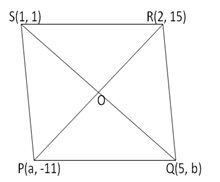
Join the diagonals PR and SQ.
They intersect each other at the point O. We know that the diagonals of a parallelogram bisect each other.
Therefore, O is the midpoint of PR as well as that of SQ
Now, midpoint of PR is ![]()
And midpoint of SQ is ![]()

Hence the required values are a = 4 and b = 3.
Question 26:
Let A(1, -2), B(3, 6) and C(5, 10) are the given vertices of the parallelogram ABCD.
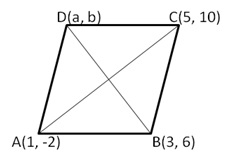
Let D(a, b) be its fourth vertex. Join AC and BD.
Let AC and BD intersect at the point O.
We know that the diagonals of a parallelogram bisect each other.
So, O is the midpoint AC as well as that of BD
Midpoint of AC is ![]()
Midpoint of BD is ![]()

Hence the fourth vertices is D(3, 2).
Exercise 16C
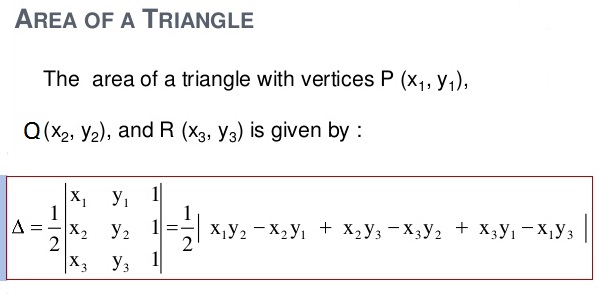
Question 1:
(i) Let A(1, 2), B(-2, 3) and C(-3, -4) be the vertices of the given ∆ ABC, then

(ii) The coordinates of vertices of ∆ ABC are A(-5, 7), B(-4, -5) and C(4, 5)
Here, x1 = -5, y1 = 7 ; x2 = -4, y2 = -5 ; x3 = 4, y3 = 5
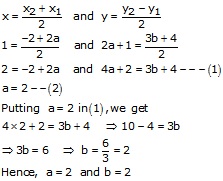
(iii) The coordinates of ∆ ABC are A(3, 8), B(-4, 2) and C(5, -1)

(iv) Let P(10, -6), Q(2, 5) and R(-1, 3) be the vertices of the given ∆ PQR. Then,

Question 2:
(i) Join A and C, then area of quad. ABCD = area of ∆ ABC + area of ∆ ACD

(ii) The vertices of quad. ABCD are A(0, 0), B(6, 0), C(4, 3) and D(0, 3)
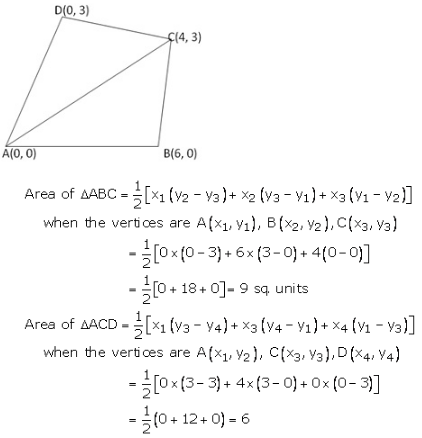
Area of quad. ABCD = Area of ∆ ABC + Area of ∆ ACD
= 9 + 6 = 15 sq. unit
(iii) Vertices of quad. ABCD are A(1, 0), B(5, 3), C(2, 7) and D(-2, 4)
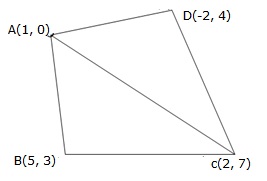
Vertices of ∆ABC are A(1, 0), B(5, 3), C(2, 7)

Vertices of ∆ACD are A(1, 0), C(2, 7) and D(-2, 4)

Area of quadrilateral ABCD

Question 3:
(i) Let A(0, 1), B(1, 2) and C(-2, -1) be the given points. Then,

Hence the given points are collinear
(ii) Let A(-5, 1), B(5,5) and C(10, 7) be the given points.

(iii) Let P(a, b + c), Q(b, c + a) and R(c, a + B) be the given points.
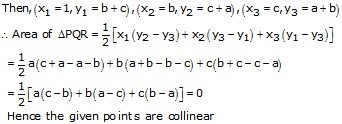
Question 4:
(i) The given points are A(-1, 3), B(2, p) and C(5, -1)
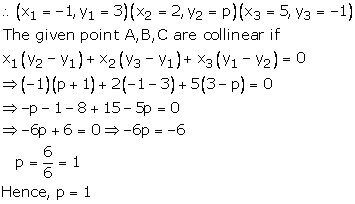
(ii) The given points are A(3, 2), B(4, p) and C(5, 3)
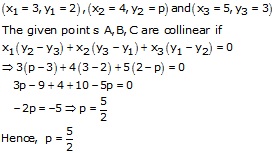
(iii) The three points are A(-3, 9), B(2, p), C(4, -5)

Question 5:
The given points are A(-3, 12), B(7, 6) and C(x, 9)
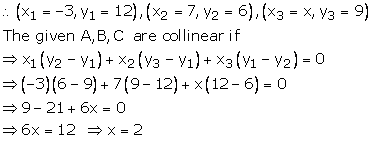
Question 6:
Let P(1, 4), Q(3, y) and R(-3, 16)
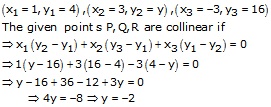
Question 7:
The given points are A(x, y), B(-5, 7) and C9-4, 5)
![]()
The given points A, B, C are collinear

Question 8:
The vertices of a quadrilateral ABCD are (-4, -2), B(-3, -5), C(3, -2) and D(2, k)
Join AC.
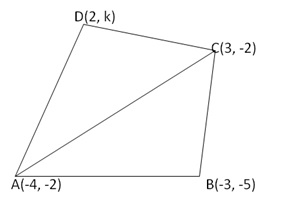
Area of quadrilateral ABCD = Area of ∆ABC + Area of ∆ACD
Now area of ∆ABC
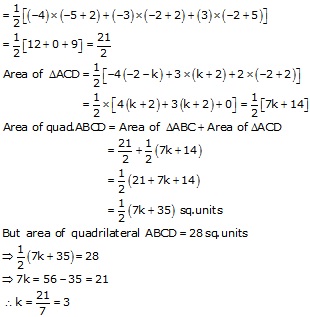
Question 9:
The vertices of ABC are A(4, -6), B(3, -2), C(5, 2)
AD is the median.
D is the midpoint of BC.
the coordinates of point D are ![]()
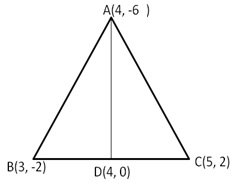
Vertices of ABD are A(4, -6), B(3, -2), D(4, 0)
Area of ∆ABD
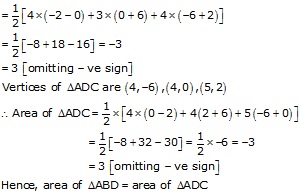
Question 10:
Vertices of ∆ABC are A(2, 1), B(x, y) and C(7, 5)
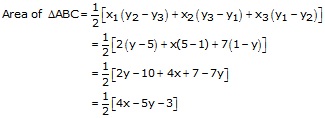
The points A, B and C are collinear
area of ∆ABC = 0
Or 4x – 5y – 3 = 0
Question 11:
The vertices of ∆ABC are (a, 0), (0, b), C(1, 1)

The points A, B, C are collinear
Area of ∆ABC = 0
ab – a – b = 0 a + b = ab
Dividing by ab

Exercise 16D
Question 1:
Distance between the points ![]()
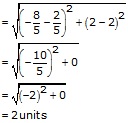
Question 2:
The points (3, a) lies on the line 2x – 3y = 5.
Substituting the values of x and y in the given equation:
2 × 3 – 3 × a = 5 or 6 – 3a = 5
⇒ 3a = 1
⇒ a = \(\frac { 1 }{ 3 } \)
Question 3:
The points A(4,3) and B(x, 5) lie on the circle with center O(2,3)
OA and OB are radius of the circle.
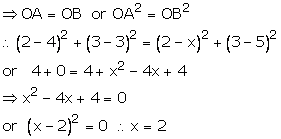
Question 4:
The point P(x, y) is equidistant from the point A(7, 1) and B(3, 5)
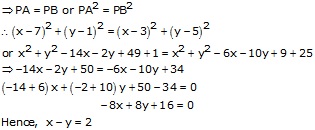
Question 5:
The vertices of ∆ABC are (a, b), (b, c) and (c, a)
Centroid is ![]()
But centroid is (0, 0)
⇒ a + b + c = 0
Question 6:
The vertices of ∆ABC are A(2, 2), B(-4, -4) and C(5, -8)
Centroid of ∆ABC is given by

Question 7:
Let the point C(4, 5) divides the join of A(2, 3) and B(7, 8) in the ratio k : 1
The point C is ![]()
But C is (4, 5)

Thus, C divides AB in the ratio 2 : 3
Question 8:
The points A(2, 3), B(4, k) and C(6, -3) are collinear if area of ∆ABC is zero

But area of ABC = 0,
⇒ k = 0
Hope given RS Aggarwal Solutions Class 10 Chapter 16 Co-ordinate Geometry are helpful to complete your math homework.
If you have any doubts, please comment below. A Plus Topper try to provide online math tutoring for you.